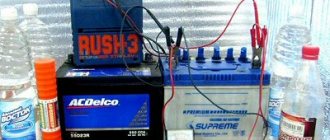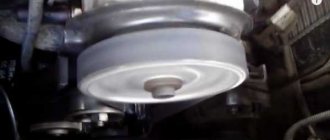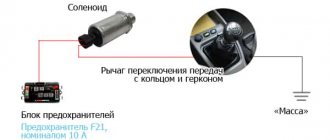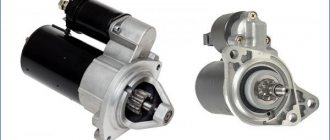Date of publication: August 11, 2021. Category: Automotive equipment.
The electrolyte is the main component of the battery, thanks to which the required amount of charge is accumulated and retained. The battery does not last forever (the service life is about 5-7 years, provided that it was purchased from a reliable manufacturer). However, sometimes car owners are faced with the fact that the battery fluid has acquired a cloudy or even black tint long before the end of the service life of this element.
The color of the new electrolyte can be compared to a child's tear. This is not surprising, because it consists only of distilled water and sulfur concentrate. Both components are completely transparent (if you look inside the battery through the open plugs, you can easily see the lead plates). If the power supply is working properly and there are no problems, then this color will not change for a very long time. If the liquid darkens or sediment appears, it is worth understanding the reasons for this manifestation and, if possible, correct the situation.
Cloudiness of the electrolyte
There are several reasons for this phenomenon. Many people believe that the whole issue is dust that got into the battery banks. However, this happens extremely rarely, especially when it comes to maintenance-free batteries, which are actually sealed containers. Therefore, we immediately cut off this reason.
If the liquid is cloudy, then it is worth remembering what kind of water was used when servicing the unit last time. You need to remember once and for all, you cannot use tap water, even if it looks very clean and transparent (and even more so process water). Only distilled liquid is suitable.
Sometimes the electrolyte remains relatively transparent, but inclusions appear in it, which form a precipitate. This indicates that we had to deal with sulfation of the plates.
If the liquid becomes cloudy and acquires a gray or lead-like tint, this indicates a severe discharge of the battery. Fortunately, all these problems can be solved on your own, without replacing the electrolyte or buying a new battery.
Reasons for changes
The appearance of cloudy electrolyte in the battery during charging, as well as simply during standard operation, can be due to several reasons.
It is important to understand here that the battery can be charged naturally during everyday use, that is, due to a running generator or by connecting a charger. In both presented cases, it is relevant to talk about the appearance of dark or black electrolyte in the battery when charging it.
If we talk about why an uncharacteristic cloudy electrolyte appears in a car battery, then we should highlight the following possible reasons.
- Violation of tightness. This may be due to a violation of the integrity of the filler plugs, improper tightening, or some damage to the housing. As a result, contaminants, lubricants, and coolant penetrate inside. Mixing leads to a change in color.
- Using poor quality water. If the electrolyte darkened literally immediately after adding fresh distilled water and this was detected when charging the battery, then the reason may lie precisely in low-quality water. Some motorists, in order to save money or due to the lack of an alternative, use regular tap water instead of distillate. Although some sellers sell more tap water under the guise of distillate. The option of purchasing low-quality electrolyte cannot be ruled out.
- Buying a low quality battery. This may turn out to be a banal fake, a battery that has been in a warehouse for at least 6-12 months. Even if the production date is fresh, but the storage rules were not followed, after the start of use of such a battery, the liquid inside may darken.
- Battery overheating during charging. The main reason why black electrolyte may appear in a battery during charging is due to violation of the charge recovery rules. Severe overheating occurred, which provoked the corresponding changes.
- Strong discharge. It is also called deep. May cause discoloration. Usually occurs due to the inattention of the driver himself, who leaves consumers turned on while leaving the car.
Obviously, dark electrolyte is not normal in a battery. Understanding why this situation can occur, appropriate recommendations have been developed to prevent problems from occurring.
Next, we should consider several situations when, during operation of the generator or during charging from the charger, the electrolyte in the battery suddenly darkens.
Much depends on what specific condition you are faced with. There are several possible options here.
Understanding what it means when the electrolyte inside the battery becomes cloudy, and perfectly assessing the degree of danger of such a phenomenon, you should develop a further action plan. Let's look separately at what to do if the color changes during charging.
Simple Troubleshooting
If you can determine that the battery is discharged, then in this case it is enough to connect the battery to the power supply and wait a while. As the charge is received, the liquid will restore its color.
When sulfating platinum, it is necessary to perform more complex manipulations. First you need to rub the battery a little. After that:
- Add a small amount of distilled water to the battery to bring the electrolyte level to normal.
- We connect the battery to the charger (it is recommended to set it for eight hours).
If during charging the electrolyte temperature exceeds 43 degrees, then it must either be kept at this level or reduced slightly. However, at this stage it is important to ensure that the voltage in one of the battery jars does not drop to a level below average (up to 0.2 V). If this happens, you must immediately stop the procedure and take the battery for repair or replace it.
Things are much worse if the electrolyte in one or several battery containers has not only lost its transparency, but has completely turned black. In this case, the problem is explained by the fact that the so-called coating of the plates (essentially lead oxide) of the battery has crumbled or the device was operated in a discharged state.
The main reasons why the electrolyte turns black
Experienced motorists know that the battery is filled with a clear liquid, which is a mixture of distilled water and sulfuric acid, combined in a certain proportion. The solution in each new battery is absolutely transparent, because it does not contain any dyes or chemical additives.
Destruction of battery plates
With proper operation and in good condition, the working electrolyte in the battery banks will continue to be cloudy, and the reasons for the loss of transparency can be various factors. It is important to pay attention when negative factors appear that cause the electrolyte to darken. This may not happen in all jars at the same time, but only in one of the working containers.
Important! It can often be observed that in maintenance-free batteries, the aqueous acid solution has become cloudy due to the opening of the case.
In this case, there is nothing unusual, because the electrical appliance is designed for a certain period of use, and after its service life expires, it is completely replaced, and not restored to its operational characteristics. In fact, the owner has no ability to influence the composition of the solution.
Users of maintenance-free devices sometimes experience cloudy liquid composition if owners drill holes in any cans and then do not seal them well. You should not do this unless absolutely necessary, since third-party interventions usually do not lead to a positive result.
In a serviced battery, you are less likely to encounter cloudy electrolyte, since the reason lies in regular monitoring of the fluid by users. By unscrewing the plug, the car owner can check the condition at any time and take the necessary measures in a timely manner.
Popular causes of cloudy fluid in the battery include:
- For old batteries with a long service life, a popular cause of contamination is the penetration of small debris and dirt into the container. This occurs due to wear of the plugs or under-tightening of the threads, as well as due to self-unscrewing.
- When charging the battery, the liquid inside may boil and evaporate. Then the owner adds water. If it is not distilled, then the salts present in it can lead to deposits during subsequent charging. Further impurities give rise to turbidity.
- You should not use low-quality ready-made electrolytes in unknown places. Even with a short period of use, the composition can lose transparency and quickly fail.
The problem with cloudy liquid can be solved by completely replacing it with fresh one. In this case, it is necessary to observe the proportions when preparing it yourself. After changing the composition, the battery is suitable for further use.
If preventive measures are not taken, the battery will overcharge and further overheat. Excessive temperature will cause the solution to change color to a darker shade. Deviations in the operation of the on-board power supply will affect the performance of the generator, relay regulator, and external charger. The composition can also negatively affect the built-in plates inside the case, which will lead to their further destruction.
Checking the electrolyte for replacement
The color change occurs due to the destruction and splitting of the plates. This happens due to a significant discharge of the battery. This changes the color of the liquid.
A decrease in density affects the possibility of freezing of the composition at low temperatures. Increasing the amount of water in the composition in this way can lead to mechanical destruction of the walls of the cans and the body as a whole when freezing.
Important! The black color of the electrolyte is a common cause of collapsing lead plates inside the housing.
Blackening of the electrolyte
If the liquid has acquired an alarmingly dark color, then you should first consider the possibility of shedding of the spread. In half the cases of such problems, everything is explained by the fact that the electrodes are covered with rust due to their advanced age. Constantly collapsing, they began to partially turn into dust, which settled in the separator bags. In such situations, as soon as the battery receives a charge, boiling occurs, during which what was once a lubricant begins to spread throughout the jar.
If a discharged battery was used, this could also lead to shedding of this material (which happens in 50% of cases). The fact is that, in terms of its chemical composition, a discharged coating (not yet crumbled) differs from a charged one. In the first case, it does not stay on the plates for long and quickly crumbles. This explains why it is strictly forbidden to shake a discharged battery vigorously.
Interesting! During the war years, tankers could be court-martialed if they let their battery discharge by more than 25%.
There are also opposite situations when the battery experiences too much voltage (about 15-16 Volts). In this case, the electrolyte begins to boil with such force that the grease falls off the plates of even a newly purchased battery. Overheating can also be caused by a malfunction of the generator or the voltage regulator. Often, such consequences are caused by the “tricks” of drivers who use homemade devices of dubious quality to charge.
Important! The temperature of the fluid in the battery cannot exceed 40 degrees. Otherwise, a chemical reaction or boiling will begin. Because of this, the electrolyte loses all its qualities and changes color.
But what to do if the liquid has become very dark? First of all, you need to check whether this happened in only one part of the battery or in the entire battery.
Replacing cloudy electrolyte in a battery
Sometimes cloudy electrolyte can be changed to restore the functionality of an old battery. To do this you need:
- Drain the old electrolyte;
- Clean the battery from dust and dirt using distilled water;
- Make sure that after washing the battery case is absolutely clean and there are no carbon chips left inside;
- Clean the electrodes from deposits and salts;
- Check the density of the newly filled electrolyte. The density should be 1.28 g/s³ m;
- Pour the solution through the funnel;
- Make sure that all the air is out of the battery case;
- Wait until all additives dissolve. Typically it takes 2 days;
- Charge the battery. It should be charged in cycles, charging and discharging the battery. The current should be supplied in the region of 0.1 ampere.
During the last action, the density should be monitored. The process is considered complete if the density remains within normal limits for 2 hours.
Thus, having identified the reason why the electrolyte has become cloudy, normal operation of the battery can be resumed or extended, and sometimes, a new one can be purchased.
In one or all banks
If the composition of only one jar becomes cloudy and blackened, you need to work with this particular container. First of all, it is recommended to check the voltage in it. It should be about 2.1 Volts. If the indicator of the “affected” bank fluctuates around 0.5 Volts or there is no voltage in it at all, while in the entire battery it is 10-10.5 V, then with a probability of 90% you can be sure that the capacity has “crumbled”, that is, the lead did not stay on the plates and fell into an unpleasant black precipitate. As soon as it starts to touch the plates, the voltage on them disappears and the can stops working. In this case, you can rack your brains about restoring such a battery, but most likely you will have to replace it.
If the liquid has become cloudy in all containers, then in this case you will have to completely replace the electrolyte. If after this it remains transparent, then most likely the cause of the previous color change lies in poor quality water.
Before moving on to drastic actions, it is worth trying to remove the dregs in the simplest way - try charging the battery (it is best to use a device for this that has a plate desulfation function). After this, you need to check the voltage at the terminals. If it is below 12.7V, then such an electrolyte cannot be saved. With a higher rate, you can count on the battery to last a little longer, but the battery capacity will be significantly lower.
What to do next
The fact that the electrolyte becomes cloudy when charging a car battery will certainly not please any driver.
But some action will have to be taken. The situation cannot be ignored, nor can it be left to chance. Otherwise, it threatens with more serious consequences. It’s better to fix the problem before it can cause any trouble.
Your further actions directly depend on specific circumstances. To do this, it is important to understand what the electrolyte has become and where it has changed. After all, a color change can affect only one jar, or all of them at once.
Therefore, it is worth considering several different situations:
- Cloudy electrolyte in all banks at the same time. Most likely, the battery was filled with low quality liquid. This applies to the electrolyte itself if it is topped up or completely replaced, as well as water. Unpurified water, not a true distillate, and simply an electrolyte of questionable origin can cause the composition to become cloudy and affect all jars at the same time. The solution is simple. You need to pump out the mixture from all the cans, rinse with distilled water, and then fill in a new solution, putting the battery on charge. If after such manipulations the mixture remains transparent, you have found the cause and successfully eliminated it.
- Gray electrolyte in all compartments. First of all, try putting the battery on charge. It would be great if the charger has a desulfation mode, since there is a high probability that it was the reason for such a change in the working composition. A deep discharge in combination with advanced sulfation processes gives this effect. But if these measures do not help, you will have to change the battery.
- The electrolyte is black or cloudy, but in one jar. If only one section of the battery is affected, the situation is somewhat different. The first step is to make sure that the remaining sections actually have clear liquid. If possible, take voltage measurements on the problem bank and on the working ones. Normally, one section should produce 2.1 V. One that has a cloudy or black electrolyte may not show voltage at all, or produce no more than 0.5 V at the output. That is, the total battery voltage will drop to 10–10.5 V with only 1 faulty section. Regarding what to do when a section forms in the battery where there is black or cloudy electrolyte, the situation is ambiguous. Such phenomena indicate shedding of the plates. And it will probably be followed by the destruction of the remaining sections. The best solution would be to replace the battery.
If the electrolyte is dark, there is nothing good for the battery. But it’s worse when changes occur in one bank.
There are enthusiasts who, even when the plates fall off, try to revive them. To do this, the body is cut, the plates are removed, cleaned, then the body is reassembled by soldering, and fresh electrolyte is poured in.
In fact, in theory, this method can bring the battery back to life for several months. In practice this is very difficult and potentially dangerous. If you make a mistake, it will negatively affect the condition of all electrical equipment, it can affect the generator, and damage the electronics. To take risks or not – the choice is quite obvious.
Electrolyte replacement
If manipulations with charging do not produce any results, then we move on to more effective measures. To do this, you first need to purchase a new electrolyte. In the store composition, the density is 1.31-1.34 g/cm3. However, for operation you will need an electrolyte with a lower value (1.27-1.29 g/cm3). To achieve this result, the finished composition is diluted with a small amount of distillate. After that:
- We clean the outer part of the battery case (so as not to accidentally introduce dirt into the jars during the process of replacing the fluid).
- We unscrew the caps of the cans (all) and remove the cloudy electrolyte.
Healthy! If you are trying to replace the fluid in a maintenance-free battery, you also need to pry it with two screwdrivers and remove the hydrometer (eye).
- We wash the inside of the battery so that there is no sediment left in the jars (you can only use distilled water and chemical cleaning fluids).
- We pour new electrolyte into the battery compartments and set it to charge at a current of 2A. During charging, the voltage should be checked periodically.
When the battery is fully charged, it is necessary to evaluate the quality of the solution, its density and level. The composition should cover all plates in each jar. At the same time, its density should remain at the same level (1.27-1.29 g/cm3). If after some time this indicator decreases, you will have to completely replace the battery.
What color should the electrolyte be?
Before you begin troubleshooting, you need to find out what color the reference mixture of sulfuric acid and distilled water used in modern batteries should be. As you know, water is a transparent liquid; concentrated sulfuric acid is also colorless and odorless.
When acid is mixed with water, a colorless liquid is formed, so if this mixture becomes colored during battery operation, the cause of this phenomenon is the substances contained in the internal plates.
Let's sum it up
As you can see, cloudy or gray electrolyte is not always a sign of final battery failure without the possibility of recovery. In this case, you need to take a comprehensive approach to the maintenance issue, that is, wash the sections, fill in fresh electrolyte according to the level, and adjust the density. Next, you need to properly charge the battery.
If blackening of the electrolyte is noted in one or more banks, and the voltage is low or absent, then this indicates active shedding of the plates. For a number of reasons, it is better not to waste time trying to restore such a battery, since even if positive results are achieved, there is no confidence that the device will continue to operate normally for a long time (especially in low temperature conditions).
It turns out that if the gray electrolyte is not yet so critical, the black electrolyte in the jars is already a good reason to scrap the existing battery and purchase a new battery. We also note that if there are problems with the generator in the car itself or when charging from the charger the battery is not charged correctly, then the new battery will quickly fail.
Why does the electrolyte in the battery become cloudy and how to fix it?
Car batteries have a service life set by the manufacturers. When used correctly, the battery can even exceed the lifespan measured at the factory. Premature failure of the vehicle power supply may also occur.
Problems can be identified by indirect signs, one of which is cloudiness of the electrolyte.
Causes of cloudiness
Cloudy electrolyte is the result of improper operation and maintenance.
The most popular reason is dirt getting inside. This should not be allowed, since the performance of the battery is significantly deteriorated and may require replacement. Quite often, the electrolyte may become cloudy due to the addition of poor quality distillate, which contains a lot of chlorine and iron. By the way, it is not recommended to add liquid yourself, and using an electrolyte of dubious origin is generally prohibited. The fact is that such products may have the wrong composition and density, and this is unacceptable.
If you exclude the reasons described above, then the cloudy electrolyte could be due to overcharging. Since this process is accompanied by shedding of the coating, it will not be possible to avoid the ingress of foreign impurities. As for overcharging, it can occur for the following reasons:
- Damage to the generator or relay regulator.
- The use of homemade or counterfeit devices when charging, which do not effectively restore the battery, but “boil” the electrolyte with high current and voltage.
- Operating a constantly discharged battery because it does not have time to recover from trip to trip. The density of the substance decreases and changes its color.
It is not uncommon for a battery to get very hot in the summer. If the electrolyte reaches a temperature of 37 degrees, this leads to its active destruction. This may result in a cloudy appearance. It is also not recommended to use ordinary water instead of distilled water, as it contains foreign metals and impurities. We mentioned excessive temperatures a little higher, but severe frosts also have a negative effect on the battery. Its freezing can lead to the formation of cracks in the monoblock, and when the electrolyte begins to thaw, it becomes cloudy.
By the way, you can also detect the reason by the uncharacteristic shade. For example, a dark residue may indicate that a significant portion of the grease has fallen off and the battery cannot function effectively. A gray tint indicates the presence of undissolved sulfate crystals. In this case, the battery needs to be charged and then the electrolyte will become transparent again.
Cloudy electrolyte. Causes
The electrolyte consists of a mixture of sulfur-based acid and purified distilled water. The composition of such a mixture contains no foreign components other than the rest; thanks to this feature, it is a transparent solution without color. In normal modes, no color changes are observed.
If the electrolyte becomes cloudy in only one jar, then the problem appeared only in that particular jar. When dark electrolyte in the battery is noted in all compartments, this may mean that the entire power supply is faulty.











